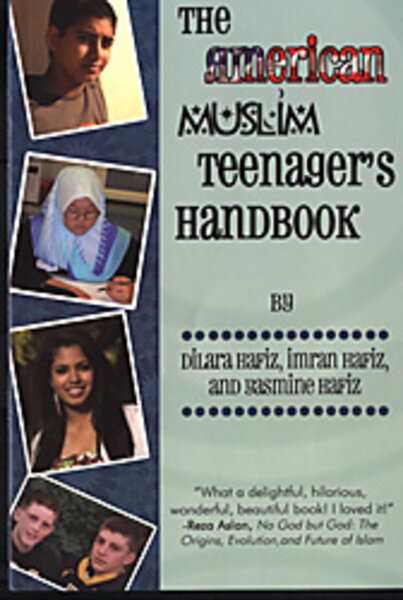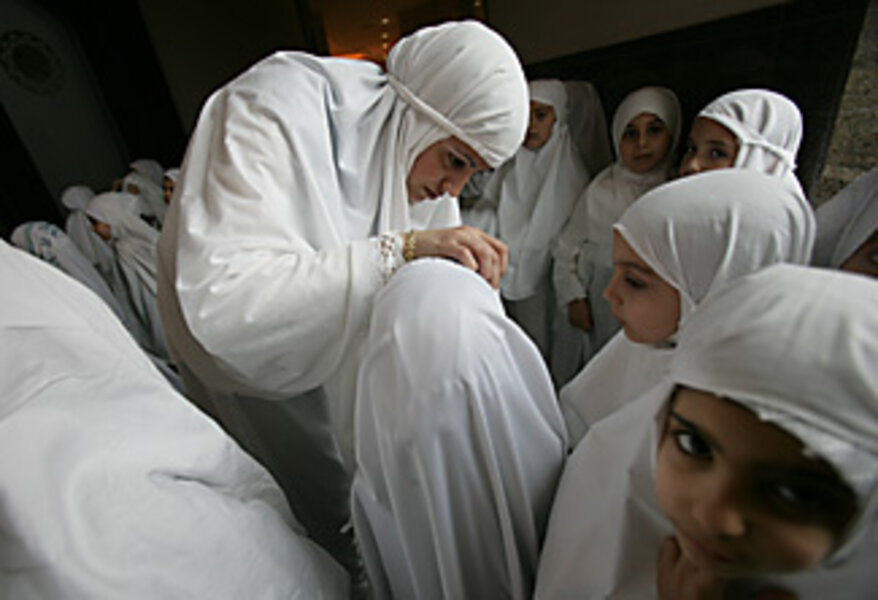A handbook for Muslim teens
Loading...
Growing up in today's culture can be exciting, confusing, and chock-full of challenges.
For young American Muslims, navigating adolescence has proven especially daunting since the events of Sept. 11, 2001. They must sort out not only who they are individually but also how they fit into a society that knows little about them but holds a host of impressions.
"I went to bed on Sept. 10th an American, and on Sept. 11th, I became a Muslim in people's minds," says Imran Hafiz, a high school sophomore in Phoenix. And not just any Muslim.
He was only in fourth grade back then, but that shift in perceptions affected Imran directly. A few days later, all of a sudden his pals at school told him, "You can't play soccer with us anymore." When he asked them why not, they responded, "Because you're a Taliban."
The youngster was shocked and scared, but his family helped him see that his friends' reaction "came from ignorance, not from hate," he says.
Since then, Imran, his older sister Yasmine, and their mother, Dilara, have been hard at work on a dual project: to write a book that could dispel that ignorance and at the same time help Muslim youths deal with the many issues that confront them. The family discussed their five-year project in a recent phone interview from their home in Paradise Valley.
"I wanted to dispel negative stereotypes and show we are normal Americans like anyone else," says Yasmine, a high school senior who will enter Yale University next year.
"The American Muslim Teenager's Handbook," published in August, is the first book of its kind, directed at filling a void Yasmine noticed as she searched the Youth/Teens section in a local Barnes & Noble bookstore. Sprinkled with humor, the lively paperback describes the essential beliefs and practices of Islam and includes questions and comments from Muslim teens across the United States.
"In addition to doing research of our own, we sent out a survey to 44 Islamic schools," explains Dilara, who teaches at a weekend Islamic school in the Phoenix area.
They received approximately 150 responses to their questionnaire, which revealed that even teens attending Islamic schools vary greatly in attitudes and faith practices, from why they are Muslim to how often they pray to whether or not they wear the hijab, the head scarf worn by many devout Muslim women. Their viewpoints appear in quotes and quizzes interspersed throughout the book's 15 chapters.
Along with "Islam 101," there's a guide to prayer and the hajj, tips on reading the Koran, and thoughtful discussion of controversial issues. One chapter deals with "the 4 'D's" – dating, dancing, drinking, and drugs.
So far, the response to the handbook has been largely positive, and even comes from beyond the US and the Muslim community.
Cynthia Berg, a Jewish mother in Phoenix who met Mr. and Mrs. Hafiz during an outreach program at her temple, likes the handbook so much she's sent copies to relatives in other cities.
"The book shows moderation in the Muslim religion and answers a lot of my questions. I thought it was ingenious," she says. "My sister-in-law in San Diego showed it to her rabbi, and they are thinking about using it in their studies."
An Episcopal school in nearby Scottsdale has adopted it as part of its curriculum. Librarians and educators from various locales have said they like the easy-to-understand, nonproselytizing explanation of the religion.
The ministry of education in Malaysia has ordered a copy. And translations are already under way in other languages – French, Dutch, and Chinese – keeping intact the book's American flavor.
"They don't want to change a word to make it less American," Dilara says. "They said that in this global age teens are plugged in and that the attraction is that it's a snapshot of the American Muslim experience."
That's exactly what Yasmine had in mind. With the handbook, she says, "I wanted to show it's possible to be Muslim and American at the same time."
She and her brother know what they are talking about. Both students attend Catholic preparatory schools in Phoenix, which the family chose for their academic quality, and say they are very happy. Imran – an avid drummer who belongs to the debate and environmental clubs and enjoys participating in theater – says he appreciates the opportunity to learn about other faiths and get involved in social justice and community issues.
Yasmine, an avid reader, considers it "great to be in a place where you can discuss religion and moral issues."
The Hafiz family has lived in Arizona since 1997, after father Hamid retired from his international banking career. During eight years living in Kuwait, the family was caught up in Saddam Hussein's 1991 invasion.
Originally from Pakistan, Dilara grew up in Washington, D.C., and has degrees from Johns Hopkins University and the London School of Economics. Both children were born in the US.
The whole family has been galvanized by the opportunity to become a voice of moderate Muslims. When they surveyed US Islamic schools for their handbook, "the response we received emphasized a desire for more guidance for teens from the mainstream, moderate viewpoint," Dilara says.
Indeed, the handbook exudes an American perspective, upbeat and nonjudgmental. It encourages teens to discuss their questions and issues with parents, friends, and others, but ultimately to make their own responsible choices about their faith practice.
"The handbook is meant to provoke discussion, not be the definitive guide to Islam," Yasmine explains. "It's something you work out with God. No one on the outside has a right to judge that."
This approach has spurred criticism from some conservative Muslims, however, who are keen on following strict rules. On the matter of prayer, for instance, the book speaks several times about the obligatory five daily prayers, but also, in response to a question, it assures a teen he can still be a Muslim if he doesn't fulfill that requirement.
As for the hijab, photos in the book include girls with and without the head scarf – as is the case in real life. Neither Dilara nor Yasmine wears one. "I think God probably cares more about what's in your head than what's on your head," Yasmine says.
Yet the handbook leaves no doubt of the family's deep commitment to their faith. They spent a year on research, three years in discussion and writing the book together, and another year getting it edited and published.
"It's been great – I've never felt so proud or open about my faith, and people are genuinely interested," Imran enthuses.
Some prominent Muslim-American authors have responded positively to their work – and Imran is particularly excited because one of his heroes, Muhammad Ali, is now reading it.
Perhaps just as significant, though, is that this time, Imran's school pals are very supportive.
"A lot of people at school are talking about it. I'm just really proud of Imran for writing this and speaking out against stereotypes," says Robert Gaelick, a junior at Brophy Preparatory School who is not a Muslim.







